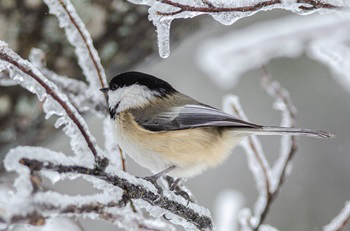Reward Offered for Death of Whooping Crane
By Glen Wunderlich
Outdoor Columnist
Member Professional Outdoor Media Association
The Audubon Society Field Guide to North American Birds lists two birds under the category of “Seriously Reduced” (as in population numbers): peregrine falcon and whooping crane. Both have received the benefit of human compassion and are being brought back from the brink of extinction. The crow-sized peregrine falcon has been introduced into the city lifestyle high atop skyscrapers – far from its natural habitat of open country settings – where it plunges at speeds up to 180 miles per hour snacking on problematic pigeons. Beyond cool!
The whooping crane on the other hand has been assisted by humans on a much more elaborate level. People dressed up like big, white birds raise the young cranes and use two techniques to help them survive. One method releases young birds directly into populations of wild whooping cranes; the other method involves training cranes to follow costumed pilots flying ultralight aircraft to their wintering grounds down South. It has been a monumental undertaking and monumental success, considering that only 21 whooping cranes existed in 1944 but have grown to an estimated 400 in the wild with the help of mankind.
Also at the hand of man, a senseless killing of one of the treasured cranes known only as 12-04 in Alabama on January 28, 2011 has garnered plenty of attention. The U.S. Fish and Wildlife Service (USFWS) is investigating the death of the crane which was reported by an Alabama conservation officer at Weiss Lake, in Cherokee County. The magnificent bird was equipped with a radio transmitter and leg bands to help track its movements. This killing comes on the heels of three other whooping cranes killed late last year, while on their first migration but not as part of the ultralight aircraft-led migration effort.
Last spring, whooping crane 12-04 had paired with 27-05, the oldest Direct Autumn Release bird. The new couple successfully mated and had a late season nest with two eggs in Juneau County, Wis., south of Necedah National Wildlife Refuge. One egg hatched and the pair raised the chick for several weeks until it disappeared, presumably taken by a predator — possibly a bobcat or coyote.
Crane 12-04 was raised in Wisconsin and was one which learned to migrate behind an ultralight aircraft flown by Operation Migration. According to the USFWS, the bird made its first migration to the Chassahowitzka National Wildlife Refuge in Florida during the fall of 2004. It annually wintered in Florida until 2009. Since then it has spent winters on the marshes in and around Weiss Lake, Alabama.
Special Agent Jim Gale has asked for the support of the public, especially the fishing, hunting, and boating community who may have seen or heard about the killing on Weiss Lake to help prosecute whoever shot this crane. Gale, who is in charge of law enforcement in the service’s Southeast region said, “We are extremely disappointed by the killing of this whooping crane…This senseless killing has got to stop.”
With only about 100 such cranes in the eastern migration population, it’s easy to understand why a $6000 reward is being offered for information that leads to a conviction.
For more information about the reintroduction effort, visit http://www.bringbackthecranes.org





